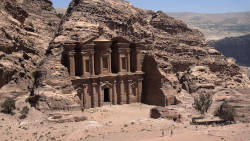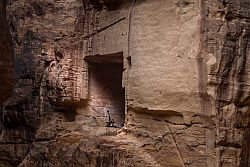Petra Cave City
Useful Information



| Location: |
Wadi el Araba, 90 km southeast of the Dead Sea.
(30.324344, 35.467840) |
| Open: |
no restrictions. Petra Tourist Information Center: All year daily 6-18. [2025] |
| Fee: |
Accommodated Visitors:
One Day JOD 50, Two Days JOD 55, Three Days JOD 60. Arabs JOD 30, Residents JOD 10, Jordanians JOD 1. Non-Accommodated Visitors JOD 90. Children (0-11) free. [2025] |
| Classification: |
 Cave Tomb Cave Tomb
 Water Supply Water Supply
 Cave Houses Cave Houses
|
| Light: |
 Incandescent Incandescent
|
| Dimension: | A=810 m asl. |
| Guided tours: |
self guided, various guided tours, night tours. 900,000/a [2022] |
| Photography: | allowed |
| Accessibility: | |
| Bibliography: | |
| Address: |
Petra Development & Tourism Region Authority, 28 Wadi Mousa, Tel: +962-3-2156-044.
E-mail: Hotline : +962-798-100-500. |
| As far as we know this information was accurate when it was published (see years in brackets), but may have changed since then. Please check rates and details directly with the companies in question if you need more recent info. |
|
History
| 312 BC | became Catital of the Nabataean civilization. |
| 106 | Nabataeans were defeated by the Roman emperor Trajan. |
| 7th century | destroyed by the Arabs. |
| 1812 | rediscovered by the Swiss traveller Johann Ludwig Burckhardt. |
| 1897-1898 | Altertumsforscher Rudolf Ernst Brünnow and Alfred von Domaszewski surveyed Petra and drew up the first modern map of the city. |
| 1907 | first scientific expedition by Alois Musil which made an inventory of the antiquities. |
| 1929 | first excavation. |
| 1930s | begin of tourism, first hotels. |
| 1958 | the British School of Archaeology begins excavating the city centre. |
| 1980s | modern visitor centre opened. |
| 1993 | 100 mi² around Petra protected as a national park. |
| 1993-2002 | Brown University from Providence (Rhode Island) excavates main temple Qasr al-Bint and the area around the Temenos Gate. |
| APR-2019 | Petra Museum next to the visitor centre opened to the public. |
Description


Petra is an ancient city, carved out of the red sandstone on the eastern slopes of the Wadi el Arabah (Arabah valley). It was the capital of the Nabataean civilization between 312 BC and 106 AD. At this time the Nabataeans were defeated by the Roman emperor Trajan and the city became unimportant. It was finally destroyed by the Arabs in the 7th century. In Europe, it was unknown until 1812, when the Swiss traveller Johann Ludwig Burckhardt (*1784-✝1817) rediscovered it. Since then the artful city in the middle of the desert was an inspiration for art, literature and even movies. We all remember the scene in the Indiana Jones movie when they follow a narrow gorge on horseback, which opens to the impressive rock cut facade.
The city covers a huge area and consists of a complex maze of irrigated land, irrigation canals, surface and subsurface buildings. Around 800 monuments and sacrificial sites have been preserved in and around Petra, in a 26 km² large area. There is a sort of city center, which actually does not exist any more, because only ruins of the buildings remain. Almost untouched by time are the impressive facades of tombs which the masons of the Nabateans cut into the solid rock face. Some of them are protected by their location in narrow slot canyons from weathering and vandalism. Because of the reddish colour of the sandstone Petra is also called the Rose City.
The site has no central spot, no starting point, and as far as we know there are no access restrictions except the climate. As a result, we have given the coordinates of the Petra Tourist Information Center at Wadi Musa, which borders the ancient city. There is the ticket office, infrastructure, the Petra Museum, and the possibility to take a guided tour. Despite the lack of a fence, the site is actually not free, there is a fee to pay, which is a little tricky, due to the strange situation. Visitors who book a day trip or multi-day trip have no problem, as all the fees are included and the guide handles all the bureaucracy. We strongly recommend this, especially as it is much safer not to drive yourself. The fees are different for tourists and locals; there is actually a kind of gradation depending on whether you are Arab, Jordanian or a local resident. Tourists get reductions if they stay overnight, and the second and third days are really cheap. In general, the site is vast and a single day is actually not sufficient to see the most important structures. There is public transport called Club Car which brings tourists from the visitor center to various spots. The price is comparable to a cab.

|
| Petra Cave City Gallery |
 Subterranean World Heritage List
Subterranean World Heritage List Search DuckDuckGo for "Petra Cave"
Search DuckDuckGo for "Petra Cave" Google Earth Placemark
Google Earth Placemark OpenStreetMap
OpenStreetMap Petra (visited: 13-JUN-2019)
Petra (visited: 13-JUN-2019) Visit Petra, official website (visited: 25-AUG-2025)
Visit Petra, official website (visited: 25-AUG-2025) Index
Index Topics
Topics Hierarchical
Hierarchical Countries
Countries Maps
Maps